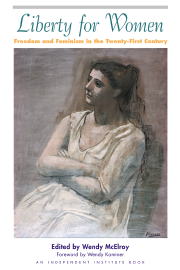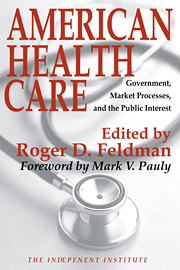36 pages
Price: $5.95
Despite the demise of the Clinton health-care proposal, public support for government intervention in the private health-insurance industry runs high. Consider, for example, the bipartisan consensus behind 1996’s Health Insurance Portability and Affordability Act, which enacted “modest” proposals to end “discrimination” in health insurance. But what exactly is the nature of such “discrimination” and how would banning it affect insurers and the public?
In Antidiscrimination In Health Care: Community Rating Systems and Preexisting Conditions, legal scholar Richard A. Epstein critically examines two ways insurers are said to discriminate unfairly: in pricing insurance according to health risk, and in limiting coverage of those who suffer from certain medical conditions before they obtained insurance.
Discriminating against Risk-Based Premiums
Insurers are often criticized for trying to match premiums with risk. But if risk is an indicator of future costs to the insurer, why shouldn’t it charge accordingly? Epstein argues that an insurer that did not classify according to risk (and therefore had low-risk customers subsidizing high-risk customers) would either drive away low-risk people or would go bankrupt. Government regulation of insurance premiums would therefore tend to create economic waste and force the healthy to subsidize the sick - to the long-run detriment of the sick and the healthy alike, he argues.
Ironically, proponents of government regulation accuse insurers of exploiting their customers. But traditionally it was the potential customers who were suspect, because those with medical problems had an interest in keeping that information a secret so they could pay lower premiums. To cope with this problem, the common law required customers to disclose their health status to their insurer. Thus, government-mandated community ratings and regulation of preexisting conditions work against the foundation upon which insurance markets were created.
Community Ratings Sufficient?
Under community rating, the classification of risk is limited to government-specified characteristics, even though other characteristics may be better predictors of risk. The Clinton proposal would have prevented insurers from classifying risk except by location and family size.
At the state level such regulations have been counterproductive. For example, New York law stipulates that when insurers classify individuals and groups of 3 to 50 individuals, they may not consider age, sex, health status, or occupa-tion when setting premiums. Epstein reports that this law has produced very undesirable (but predictable) effects: the young and the healthy now subsidize the older and infirm. And because younger people are generally less wealthy than older people, a further effect is that the poorer subsidize the richer.
Cross-subsidies harm insurers and most customers in several ways. Epstein notes five implications of standard economic theory that apparently have been confirmed by New York’s experience.
- Penalizing healthy workers: Because insurers are not allowed to distinguish between people with jobs and people without jobs, unemployment is subsidized and employers have less incentive to keep their workers healthy.
- Penalizing young workers: The subsidy drives younger workers out of plans. In one plan the median age of policyholders rose by 3.5 years within a year of the law’s operation.
- Adverse selection: Community rating requires that some insurance companies subsidize others that attract people with higher medical costs.
- Moral hazard: Shifting the costs of risk through cross-subsidy encourages some people to engage in dangerous activities from which they might otherwise have abstained.
- Draining the insurance industry: The industry’s financial condition worsens as healthy people drop out and sickly people increase their claims. Efforts to prevent customers from exiting the system (for example, mandated insurance) bring their own problems. Net payers will have an interest in seeing benefits shrink because that would reduce the subsidy.
“The antidiscrimination norms thus have powerful negative effects,” Epstein writes, “even when, and precisely because, the exit option is foreclosed by legislation.”
Preexisting Conditions
The Health Insurance Act greatly reduces the ability of insurers to exclude coverage of preexisting conditions or impose waiting periods before coverage begins. This provision was advocated in the name of fairness. For Epstein, however, the irony is that “fairness means unequal benefits for equal contributions.”
The issue of preexisting conditions has become more sensitive with the advent of genetic testing. “As might be expected,” he writes, “the dominant view is that any effort to set insurance rates with reference to these genetic conditions should be regarded as stigmatizing of certain individuals, and the result of base and irrational prejudices against them.” But, Epstein asks, “should individuals have legal claims against others who are in no sense responsible for their conditions?”
Preexisting conditions concern insurers for obvious reasons. Insurers cannot stay in business if they sign up people who will assuredly and immediately incur large medical expenses. As Epstein puts it, “The entire scope and function of these clauses [governing preexisting conditions] are to ensure the minimum conditions for stability in contracting: namely, that all those parties to the contract are left better off after signing than they were before, without which voluntary markets will surely unravel.”
Critics of the exclusion of preexisting conditions charge that insurance companies want to avoid writing policies. But Epstein shows that claim to be absurd: the companies don’t exclude the ill person entirely, just the condition. If they cannot exclude the condition, they will try to exclude the person instead. Prohibiting the exclusion would trigger serious unintended consequences. For example, young, healthy people would be less likely to buy insurance, knowing they could obtain coverage later. Without the prohibition, young people either buy insurance or at least avoid risky activities.
Disallowing the exclusions, therefore, would aggravate the well-known “moral hazard problem,” in which the rules governing insurance help create more of what is insured against. Epstein argues that if the government tried to compensate for this effect by forcing people to take preventative action, it would have to meddle in nearly every area of life.
Epstein then argues that the problems of government intervention in the insurance market are aggravated by related regulations such as the Americans with Disabilities Act, which prohibits employers from asking job applicants whether they have disabilities. This law encour-ages employers to locate away from inner cities (where the risks are seen as higher), shift to independent contractors, and reduce health benefits. Wages can also be expected to be reduced because of more expensive insurance costs.
Epstein agrees that the exclusion of preexisting conditions reduces the mobility of labor. But he counters that contractual arrangements, rather than government intervention, can deal with that problem.
Letting the insurance industry deal with preexisting conditions as it wishes would be best, Epstein writes, because the resulting produc-tivity gains would benefit people with such conditions. An alternative would be to subsidize such people outright rather than indirectly through insurance regulation. At least the subsidy would be visible and subject to public deliberation.
But Epstein wonders if a program of that kind could be properly constructed. “In the end,” he concludes, “one despairs of doing anything sensible through the political process. Of all the alternatives, charitable assistance without government intervention still seems intellectually to be the best - but politically the least feasible.”










